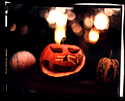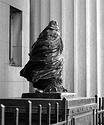Also bear in mind that those were most likely shot with an 8x10 camera, not medium format. Not that you can't approximate that look with 645, but you won't be able to match it exactly. Also, both the film he used and the paper he used for those shots is discontinued. There does seem to be a bit of sabbatier effect in the image, which in this case was done on the film, not to the print. Sabbatier on the print will be much more heavy-handed and harder to control.
He shot those images of the dancer Bertha Wardell on his 4x5 Graflex, IRRC. The prints are all smaller than 8x10. I have the impression preferred silver chloride and above all platinum papers (you could buy them ready made in those days). The dancer photos are listed as silver gelatin, but I can't find any information in my Weston stuff regarding films.
The copies of the images as I have them have a definite smooth grain, but clearly not solarized or reversed. This same grain structure is apparent in quite a few of his interior portraits and still life work, and informs the tone a great deal. I don't think it is anything peculiar to the materials of the era.
Last edited by a moderator:







